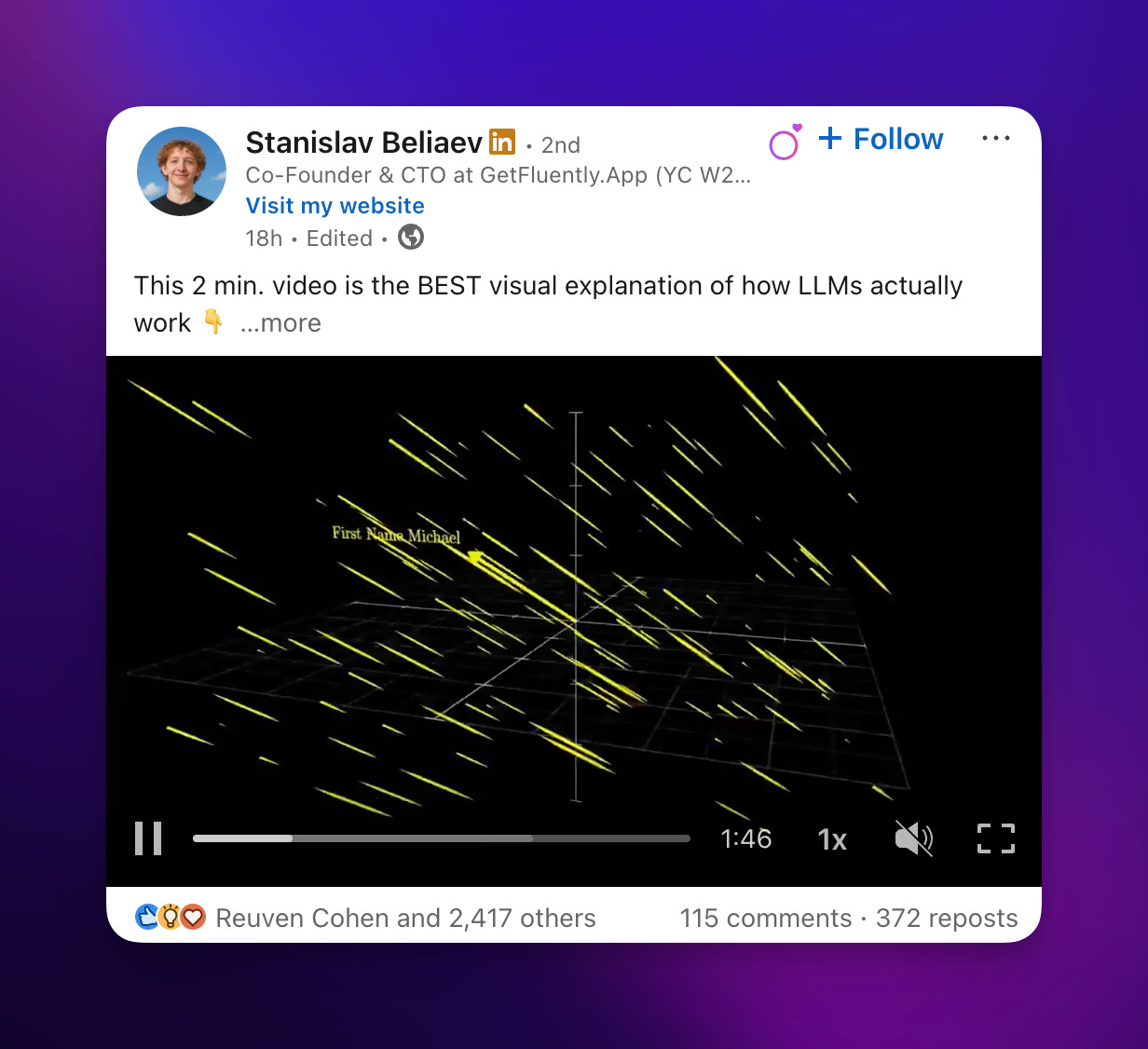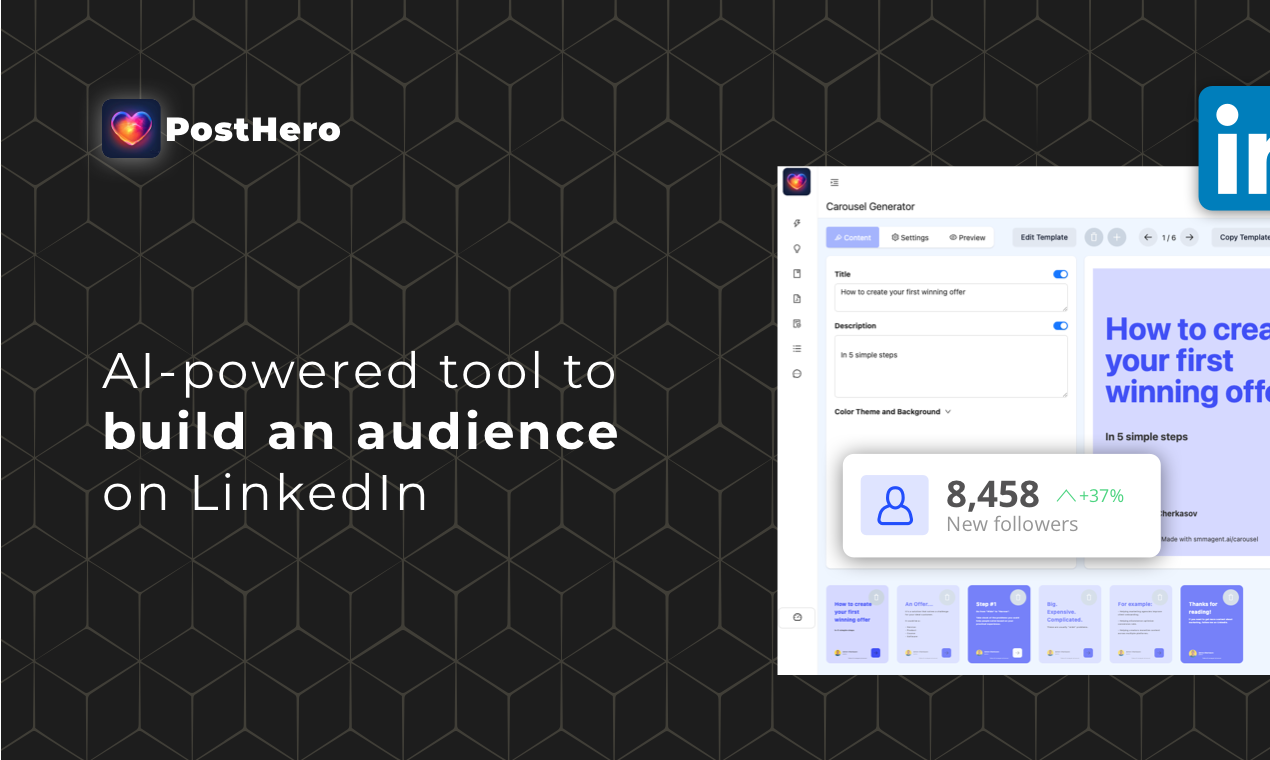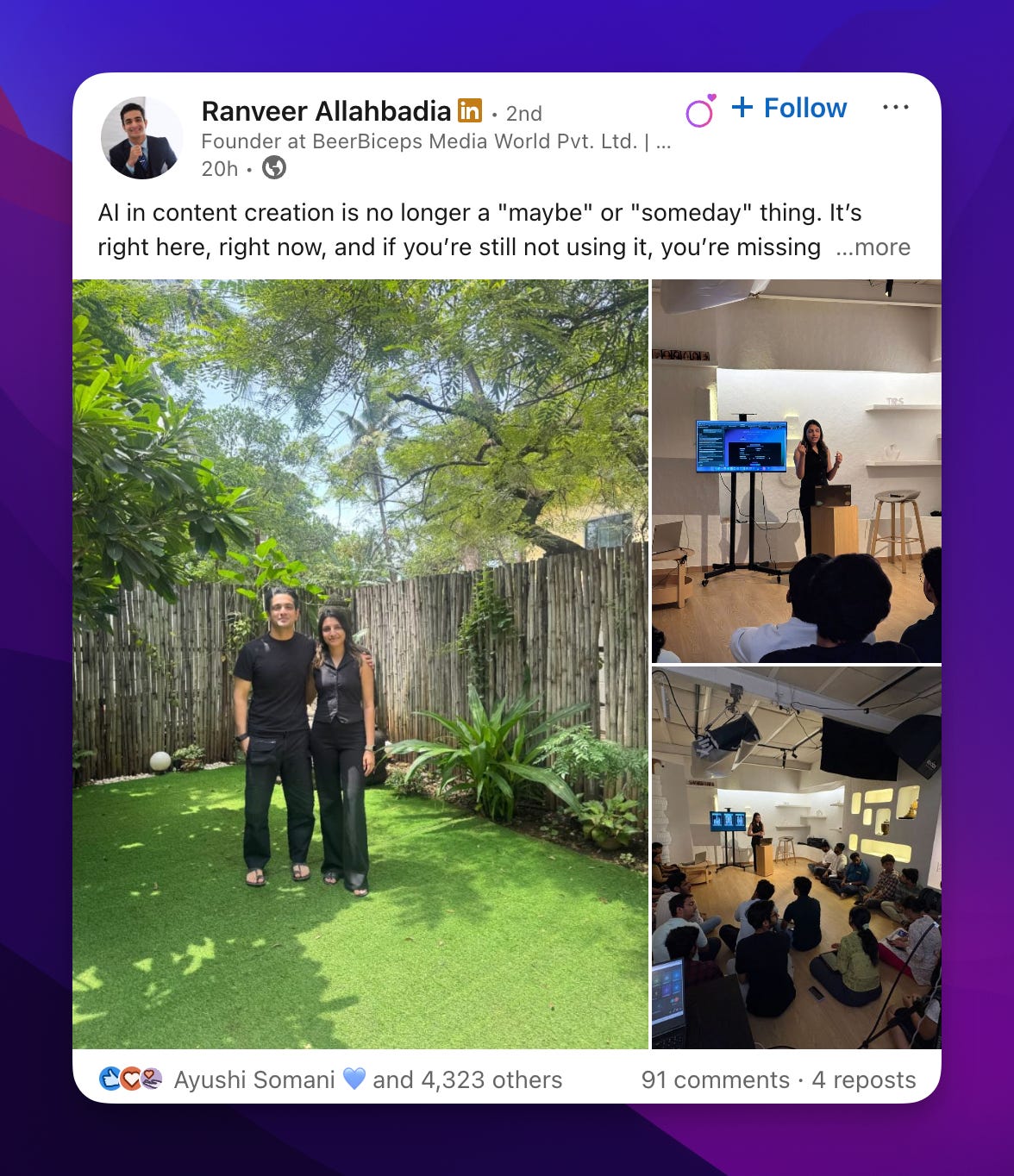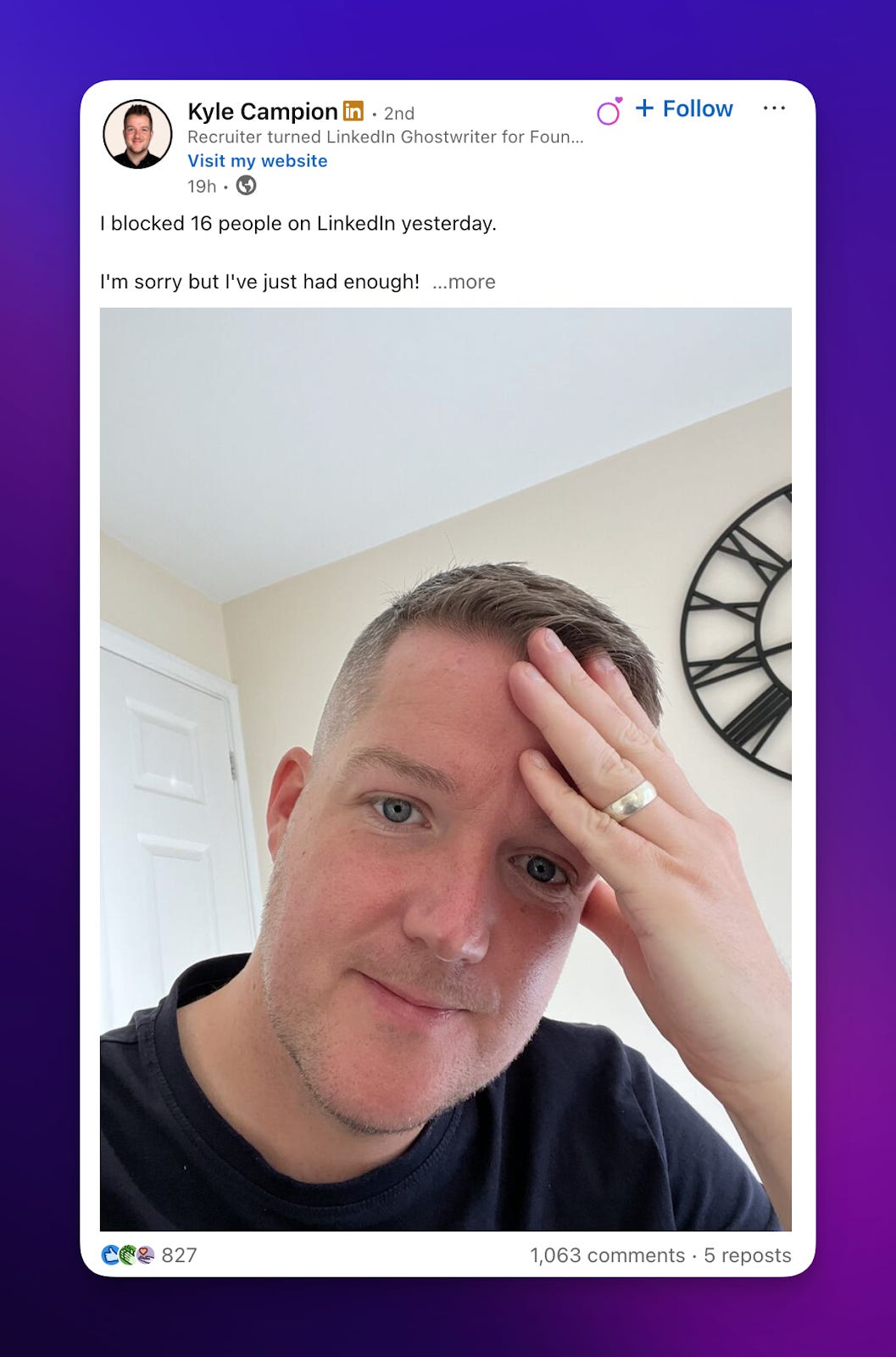LS #56: LinkedIn Personal Branding: The 2025 Founder's Guide
Most founders build companies but forget to build themselves.
Hi there,
I analyze top LinkedIn posts to help you craft content that resonates.
In this issue, you'll find:
The 3 high-performing LinkedIn posts this week
LinkedIn Personal Branding: The 2025 Founder's Guide
The 3 high-performing posts this week
1. This 2 min. video is the BEST visual explanation of how LLMs actually work
Why this post?
This post went viral, receiving almost 2.4k likes in just 18 hours. It received 7-25 more engagement and views than Stanislav's posts this week.
BREAKDOWN
Bold claim hook: "This 2 min. video is the BEST visual explanation" - big promise that grabs attention
Complex topic made simple: Takes scary AI tech and makes it understandable with visuals
Relatable example: Uses "Michael Jordan plays basketball" to explain how AI learns
Step-by-step breakdown: 6 clear steps that walk through the entire process
Visual proof: Cool 3D graphics and animations that make abstract concepts concrete
Personal endorsement: "I've watched almost all 3Blue1Brown videos" - shows his expertise
HOW TO CREATE YOUR OWN POST:
Promise the best explanation: Make a bold claim about having the clearest way to understand something
Use familiar examples: Explain complex topics through things everyone knows (like basketball)
Break it into steps: Number your explanation so people can follow along easily
Show, don't just tell: Use visuals, graphics, or videos to make abstract ideas concrete
Mix simple and technical: Use proper terms but explain them in everyday language
POST IDEAS FOLLOWING THIS TEMPLATE:
"How blockchain actually works (explained with pizza delivery)"
"Why your website loads slow (visualized step-by-step)"
"How Netflix recommends shows (using your favorite coffee shop)"
"Why passwords get hacked (explained with house keys)"
"How Google search really works (like organizing a massive library)"
TOGETHER WITH POSTHERO
Grow your audience faster on LinkedIn. With an AI-powered tool that helps you create content and grow on LinkedIn.
Create high-converting content that helps you grow on LinkedIn
Create a weekly content in 76 seconds
AI Voice assistant for creating content in seconds
2. AI in content creation is no longer a "maybe" or "someday" thing.
Why this post?
Another post that went viral this week—it got 4.3 likes in a day and performed 3-6 times better than Ranveer’s other posts this week.
BREAKDOWN:
Urgent reality check: "AI in content creation is no longer a 'maybe' or 'someday' thing" - creates FOMO
Direct warning: "if you're still not using it, you're missing out" - makes people feel behind
Personal credibility: "After 10 years in content creation" - shows he's seen it all
Expert introduction: Names Gayatri Agrawal and builds up her credentials before the main point
Problem identification: "the grind" of content creation that everyone relates to
Solution presentation: AI as the game-changer that solves real problems
Specific benefits: Lists exactly what AI can do (writing scripts, brainstorming, SEO)
HOW TO CREATE YOUR OWN POST:
Create urgency: Tell people they're already behind if they're not doing something
Use your experience: Share how long you've been in the field to build authority
Introduce an expert: Bring in someone credible to support your point
Identify the universal pain: Point out problems everyone in your industry faces
Present the solution: Show how new technology or methods solve old problems
Give specific examples: List exactly what the solution can do for people
3. I blocked 16 people on LinkedIn yesterday.
Why this post?
This post performed 2.5-5 times better than Kyle’s other posts this week.
BREAKDOWN:
Shocking confession: "I blocked 16 people on LinkedIn yesterday" - immediately grabs attention
Perfect visual: Hand over forehead photo showing exhaustion and frustration
Clear villain: AI comment writers who are ruining authentic conversations
Growing problem: "it seems to be getting worse" - makes it feel urgent and widespread
List of demands: Simple bullet points showing what he actually wants (real comments, real banter)
Memorable comparison: "If I wanted a bot's opinion I'd go to ChatGPT" - clever and quotable
Join the movement: "I've seen others taking this stand. And now I'm joining them" - creates community
HOW TO CREATE YOUR OWN POST:
Take a controversial stand: Pick something that's annoying you that others probably feel too
Show genuine emotion: Use photos or language that reveals how you really feel
Name the problem clearly: Don't dance around it - say exactly what's bothering you
Make it personal: Explain why this matters to you and your experience
Create an us vs. them dynamic: Position good people vs. bad behavior
Use simple comparisons: Make your point with analogies people instantly understand
LinkedIn Guide
LinkedIn Personal Branding: The 2025 Founder's Guide
Most founders build companies but forget to build themselves.
They have amazing products, solid teams, and growing revenue. But their LinkedIn looks like a corporate press release factory.
Meanwhile, I’ve built a personal brand that brought a founder 30+ inbound leads each month and unlocked over $100K in opportunities.
The secret? Stop acting like a CEO. Start acting like a human who happens to run a company.
The Personal Branding Reality Check
What doesn't work in 2025:
Corporate headshots with arms crossed
Bios that read like job descriptions
Only posting company updates and wins
Playing it safe with vanilla content
What actually builds brands:
Authentic stories about the founder journey
Behind-the-scenes struggles and lessons
Strong opinions on industry topics
Personal vulnerability mixed with expertise
The 3-Layer Personal Brand System
Layer 1: The Foundation (Your Profile)
Headline Formula That Works: Instead of: "CEO at TechCorp | Growing B2B Software Solutions" Use: "I help SaaS founders reduce churn from 15% to 3% | Scaled 3 companies from $0 to $10M ARR"
Bio Structure:
Line 1: Specific problem you solve + for whom
Line 2: Credibility marker (results, experience, recognition)
Line 3: Personal element (mission, values, or story)
Line 4: Call to action
Example bio: "I help B2B SaaS founders build products customers actually want to keep using.
Reduced churn for 200+ companies. Built and sold 2 startups. Former Product Lead at [Company].
Obsessed with turning user feedback into product wins (and preventing expensive feature mistakes).
Building in public → follow for honest startup lessons."
Layer 2: The Content Engine
The 70-20-10 Content Rule:
70% Educational: Lessons learned, how-to guides, industry insights
20% Personal: Behind-the-scenes, failures, team moments
10% Promotional: Product updates, company news, hiring
Content Pillars That Build Authority:
Pillar 1: The Startup Journey (40% of content)
Weekly lessons learned
Mistakes and how you fixed them
Decision-making processes
Team building challenges
Example post: "How I almost killed our startup with one hiring decision:
Hired a VP of Sales who looked perfect on paper. 15 years experience. Worked at 3 unicorns.
First red flag: He wanted to completely change our sales process on day 1.
Second red flag: He stopped using our product during demos.
Third red flag: Our close rate dropped 60% in month 2.
The lesson: Culture fit beats experience every time. Skills can be taught. Attitude can't.
What's your biggest hiring mistake?"
Pillar 2: Industry Insights (30% of content)
Contrarian takes on common practices
Trend predictions and analysis
Framework sharing
Tool recommendations
Pillar 3: Behind-the-Scenes (20% of content)
Team moments and celebrations
Office/remote work insights
Personal productivity systems
Book/resource recommendations
Pillar 4: Thought Leadership (10% of content)
Where the industry is heading
Challenges that need solving
Your unique perspective on problems
Layer 3: The Engagement Strategy
The Comment Gold Mine: Your comments are often more valuable than your posts. They show up in others' feeds and demonstrate your expertise.
High-Value Comment Formula:
Acknowledge their point
Add your perspective or experience
Ask a follow-up question
Example: "Great point about product-market fit, [Name]. We experienced something similar at [Company] - thought we had PMF at 100 customers, but realized we were just good at convincing people to try us, not stick around.
The real test came when we stopped all sales efforts for 30 days. Growth dropped to zero.
How do you distinguish between early adopter enthusiasm and real PMF?"
The Personal Brand Content Calendar
Monday: Motivation/Mindset
Lessons learned over the weekend
Industry predictions for the week
Personal motivation or goal-setting
Tuesday: Tactical Tuesday
How-to guides and frameworks
Tool recommendations
Process explanations
Wednesday: Behind-the-Scenes
Team highlights or challenges
Company culture moments
Decision-making processes
Thursday: Thought Leadership
Industry analysis and predictions
Contrarian takes on common practices
Framework or methodology sharing
Friday: Reflection/Community
Weekly lessons learned
Ask the community questions
Share favorite resources or reads
Personal Branding Mistakes That Kill Credibility
1. The Humble Brag Overdose
"So humbled by our $5M Series A..." Share wins, but focus on lessons learned and what's next.
2. The Perfect CEO Act
Never sharing failures, struggles, or human moments. Vulnerability builds trust faster than perfection.
3. The Feature Factory
Only posting about product updates and company news. Your audience follows you, not your company.
4. The Generic Wisdom Dealer
Sharing obvious business advice everyone's heard. Your unique experiences are more valuable than general wisdom.
Advanced Personal Branding Tactics
The Story Bank System
Keep a running list of:
Major business decisions and outcomes
Hiring/firing lessons learned
Customer success/failure stories
Personal growth moments
Industry observations
Monthly content planning: Review your story bank and plan 4-5 posts around your best stories.
The Conversation Starter Strategy
End posts with questions that generate real discussion:
"What's your biggest [relevant challenge]?"
"How do you handle [specific situation]?"
"What would you do differently in my situation?"
The Authority Building Loop
Share framework or insight
People comment with questions
Respond with additional value
Move conversation to DMs
Build relationships that lead to opportunities
Personal Brand Metrics That Matter
Engagement metrics (track these):
Comments per post
Quality of conversation in comments
DMs from qualified prospects
Business metrics (optimize for these):
Inbound leads from LinkedIn
Partnership opportunities
Revenue attributed to personal brand
The Personal Branding ROI Formula
Authentic Stories (humans connect with humans) + Consistent Value (teach what you've learned) + Strategic Engagement (conversations over broadcasting) + Long-term Thinking (relationships compound) = Personal brand that drives business results
Your personal brand isn't about you. It's about the value you provide to others.
That's a wrap for today.
See you next week! If you want more LinkedIn tips, be sure to follow me on LinkedIn (link).
If you love this episode and want to support us, spread the word about us by sharing The LinkedIn Secrets with colleagues. I really appreciate it!
Thank you for reading!
What'd you think of today's edition?
Help me to understand what you think about this episode. Just reply with a number (1, 2, or 3) to this email.
1 - Damn good
2 - Meh, do better
3 - You didn't cook it
Your compadre,
Anton "LinkedIn growth strategies" Cherkasov






Great share!